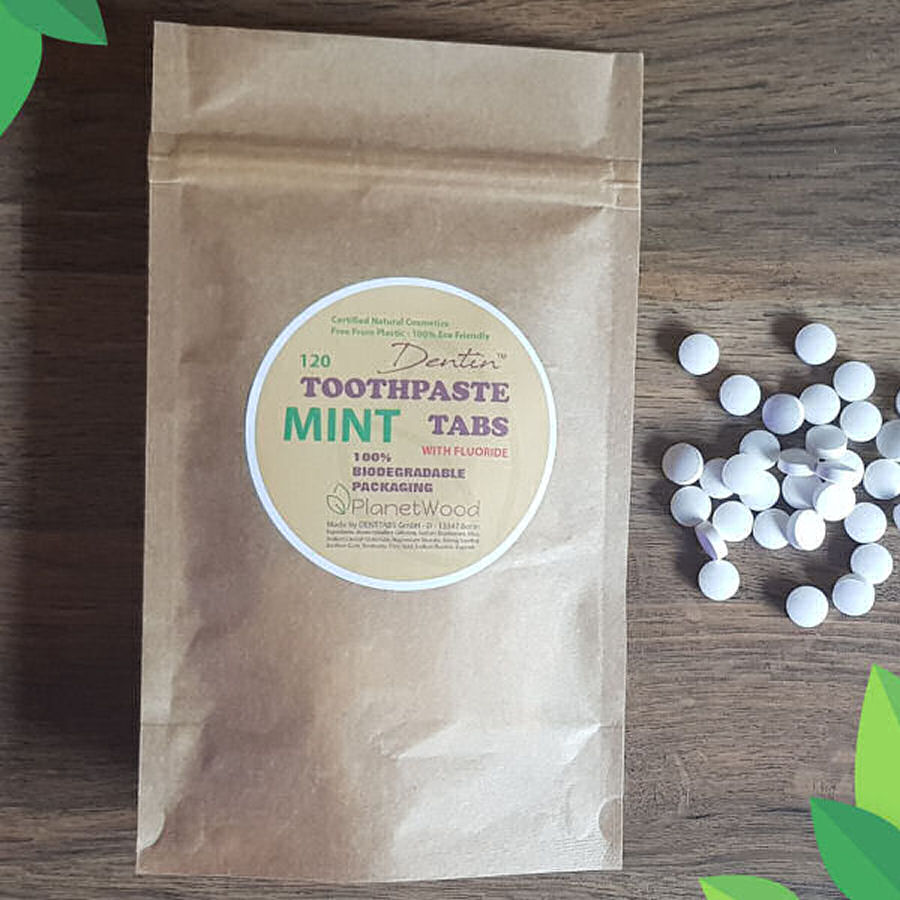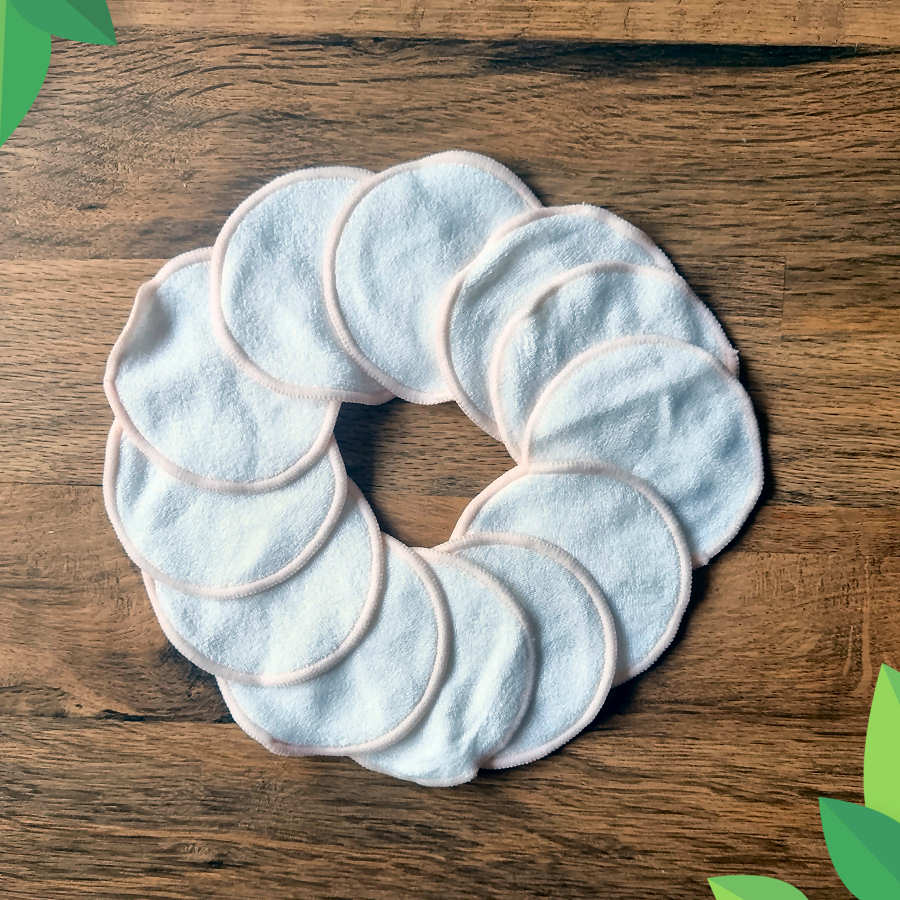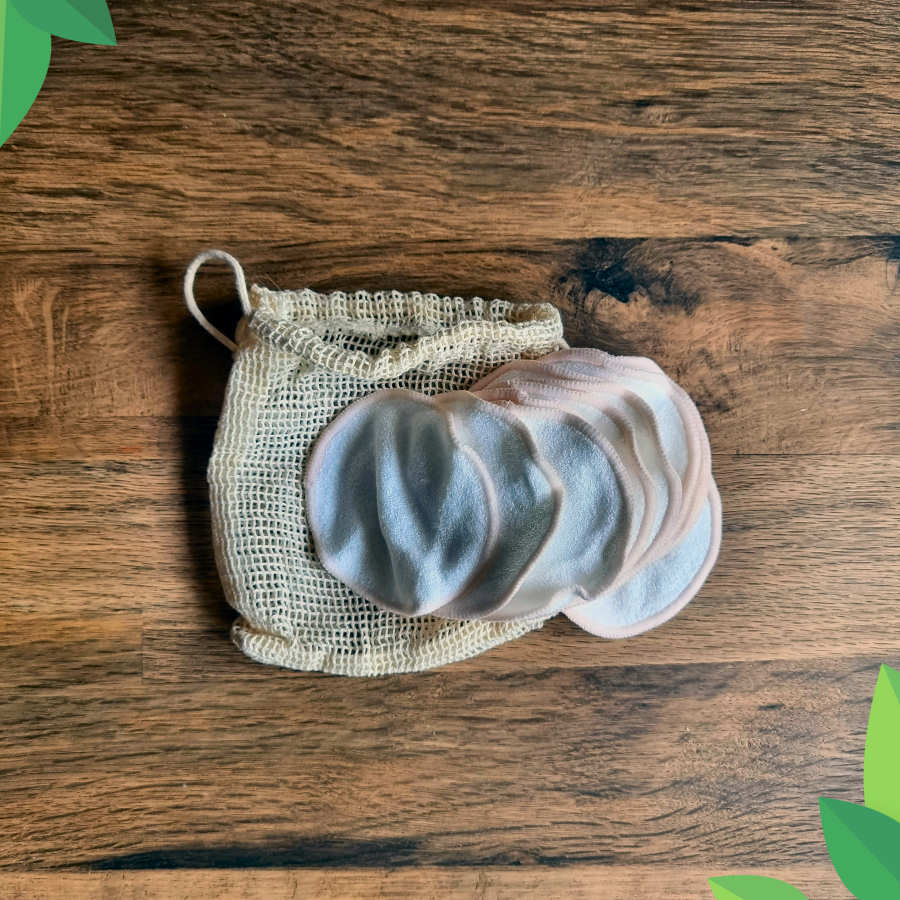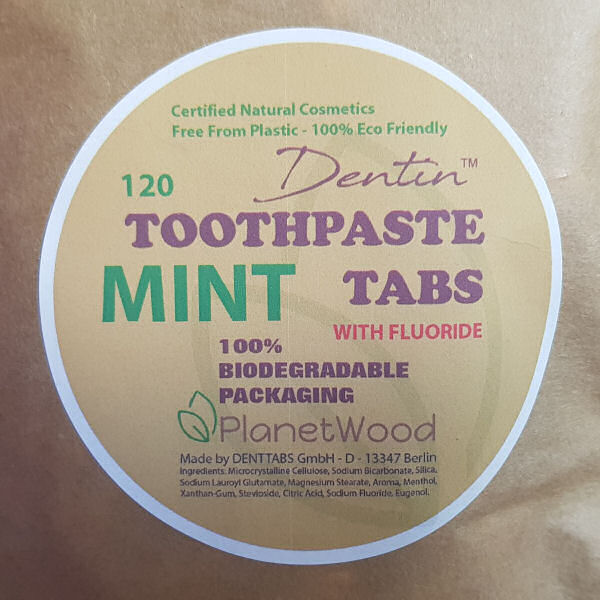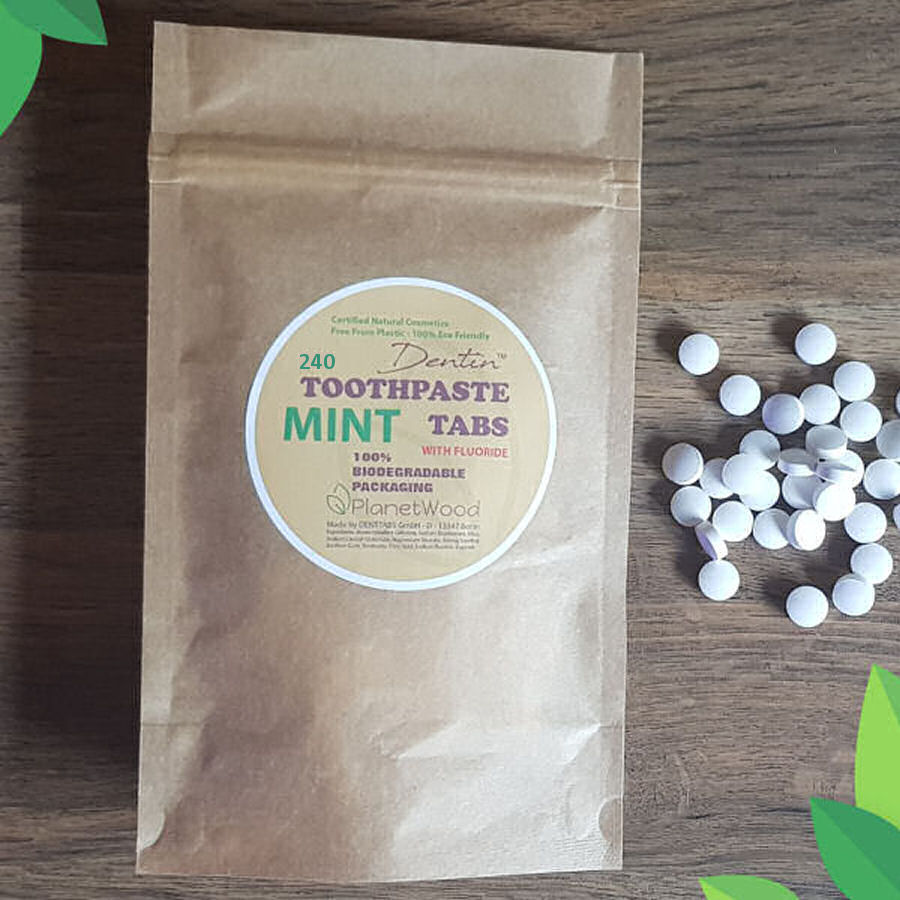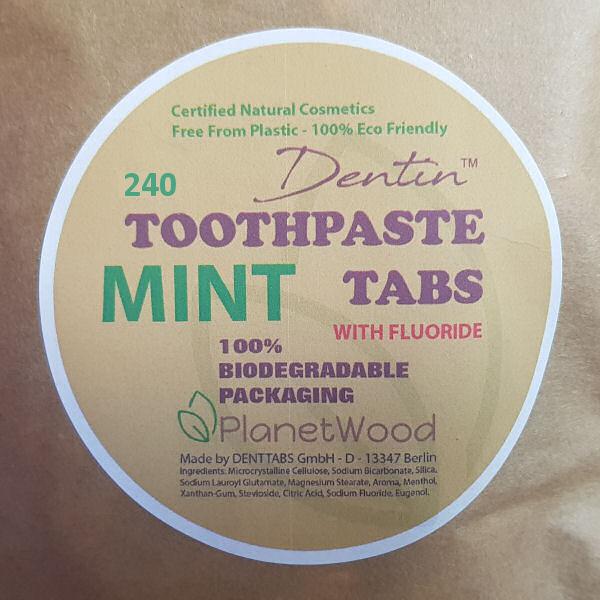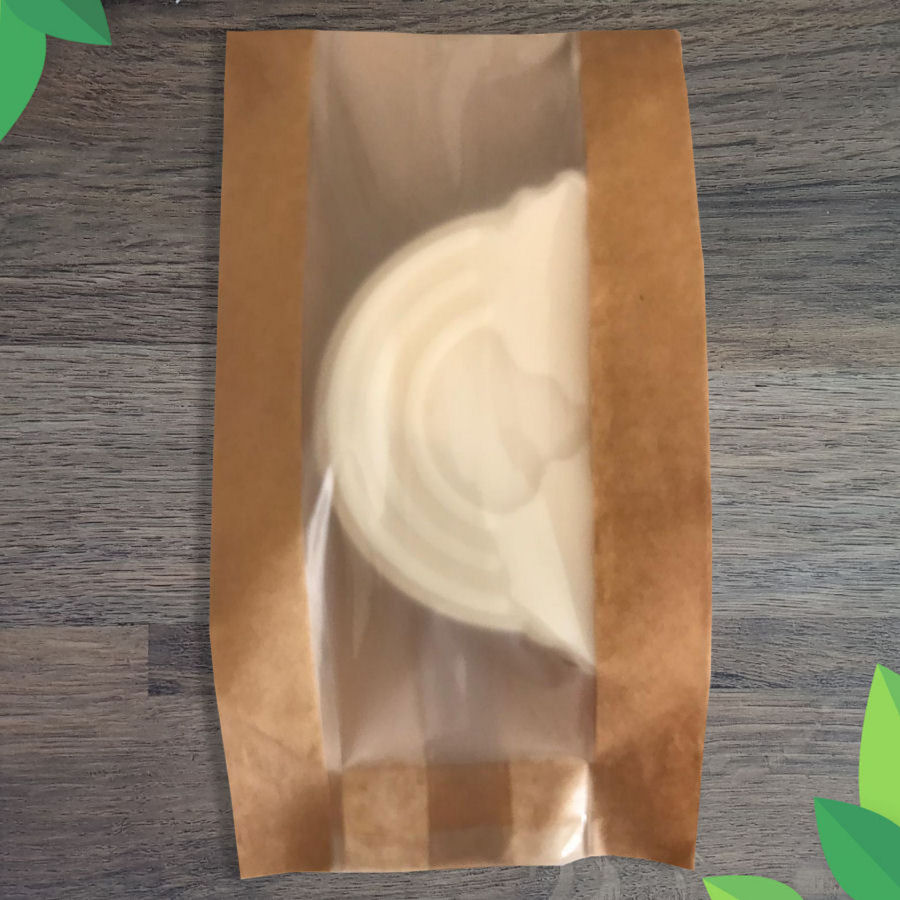Dentin ™
Mint Toothpaste Tabs
£5.99
- Brand: Dentin ™
- Product Code: PWTT001-MINT
- Availability: In Stock
- Our solid toothpaste is 100% natural and eco-friendly. They are Mint flavoured, Vegan & easy to use. Kind on sensitive teeth and gums, are SLS Free & suitable for travelling with as they are not a liquid.
Our tablets will clean your teeth better than plastic tubed varieties & they contain Fluoride providing the only proven protection against cavities. Safe for adults and children (under supervision).
Glutamate & Gluten Free. Our teeth cleaning tablets are BDIH Certified Natural Cosmetics made by Denttabs. Our standard packs contain 120 toothpaste tablets, enough for 2 months.
Dentin ™
Mint Toothpaste Tabs Trial
£2.99
- Brand: Dentin ™
- Product Code: PWTT001-MINT_03
- Availability: In Stock
- Try our toothpaste tablets by ordering this 2 week trial pack which contains 30 tabs.
Our solid toothpaste is 100% natural and eco-friendly. They are Mint flavoured, Vegan & easy to use. Kind on sensitive teeth and gums, are SLS Free & suitable for travelling with as they are not a liquid.
Our tablets will clean your teeth better than plastic tubed varieties & they contain Fluoride providing the only proven protection against cavities. Safe for adults and children (under supervision).
Glutamate & Gluten Free. Our teeth cleaning tablets are BDIH Certified Natural Cosmetics made by Denttabs.
Dentin ™
240 Mint Toothpaste Tabs
£11.49
- Brand: Dentin ™
- Product Code: PWTT001-MINT_240
- Availability: In Stock
- Our solid toothpaste is 100% natural and eco-friendly. They are Mint flavoured, Vegan & easy to use. Kind on sensitive teeth and gums, are SLS Free & suitable for travelling with as they are not a liquid.
Our tablets will clean your teeth better than plastic tubed varieties & they contain Fluoride providing the only proven protection against cavities. Safe for adults and children (under supervision).
Glutamate & Gluten Free. Our teeth cleaning tablets are BDIH Certified Natural Cosmetics made by Denttabs. Our double packs contain 240 toothpaste tablets, enough for 4 months.
Dentin ™
Fluoride Free Mint Toothpaste Tabs
£5.99
- Brand: Dentin ™
- Product Code: PWTT002-MINT
- Availability: In Stock
- Our solid toothpaste is 100% natural and eco-friendly. They are Mint flavoured, Vegan & easy to use. Kind on sensitive teeth and gums, are SLS Free & suitable for travelling with as they are not a liquid.
Our tablets will clean your teeth better than plastic tubed varieties & these are Fluoride free. Safe for adults and children (under supervision).
Glutamate & Gluten Free. Our teeth cleaning tablets are BDIH Certified Natural Cosmetics made by Denttabs. Our standard packs contain 120 toothpaste tablets, enough for 2 months.
Dentin ™
Fluoride Free Mint Tabs Trial
£2.99
- Brand: Dentin ™
- Product Code: PWTT002-MINT_03
- Availability: In Stock
- Try our toothpaste tablets by ordering this 2 week trial pack which contains 30 tabs.
Our solid toothpaste is 100% natural and eco-friendly. They are Mint flavoured, Vegan & easy to use. Kind on sensitive teeth and gums, are SLS Free & suitable for travelling with as they are not a liquid.
Our tablets will clean your teeth better than plastic tubed varieties & these are Fluoride free. Safe for adults and children (under supervision).
Glutamate & Gluten Free. Our teeth cleaning tablets are BDIH Certified Natural Cosmetics made by Denttabs.
Dentin ™
240 Fluoride Free Mint Tabs
£11.49
- Brand: Dentin ™
- Product Code: PWTT002-MINT_240
- Availability: In Stock
- Our solid toothpaste is 100% natural and eco-friendly. They are Mint flavoured, Vegan & easy to use. Kind on sensitive teeth and gums, are SLS Free & suitable for travelling with as they are not a liquid.
Our tablets will clean your teeth better than plastic tubed varieties & these are Fluoride free. Safe for adults and children (under supervision).
Glutamate & Gluten Free. Our teeth cleaning tablets are BDIH Certified Natural Cosmetics made by Denttabs. Our double packs contain 240 toothpaste tablets, enough for 4 months.
Leaf ™
Bamboo Toothbrush
£2.99
- Brand: Leaf ™
- Product Code: PWTB001
- Availability: In Stock
- Our toothbrushes are almost completely biodegradable but, still very environmentally friendly!
The bristles we use are BPA-Free Soft Nylon-6, a synthetic polymer. Easily removed to be recycled.
Bamboo and Nylon-6 are completely safe to use, for both you and the environment.
Leaf ™
Bamboo Toothbrushes X 4
£8.95
- Brand: Leaf ™
- Product Code: PWTB001_4
- Availability: In Stock
- Pack of 4 of our signature brushes. Our toothbrushes are almost completely biodegradable but, still very environmentally friendly!
The bristles we use are BPA-Free Soft Nylon-6, a synthetic polymer. Easily removed to be recycled.
Bamboo and Nylon-6 are completely safe to use, for both you and the environment.
Oris ™
Organic Unscented Lip Balm 15ml
£3.48
- Brand: Oris ™
- Product Code: PWLB001_15
- Availability: In Stock
- All of our 15ml Organic Lip Balms are made with 100% natural & organic ingredients to leave your lips silky soft, soothing and moisturising them without any irritation.
Oris unscented lip balm can be used all over to help with dry skin problems such as Eczema or Psoriasis. It protects your skin against the elements and helps to heal dry, chapped lips.
Oris ™
Organic Unscented Lip Balm 30ml
£6.49
- Brand: Oris ™
- Product Code: PWLB001_30
- Availability: In Stock
- All of our 30ml Organic Lip Balms are made with 100% natural & organic ingredients to leave your lips silky soft, soothing and moisturising them without any irritation.
Oris unscented lip balm can be used all over to help with dry skin problems such as Eczema or Psoriasis. It protects your skin against the elements and helps to heal dry, chapped lips.
Touch ™
Reusable Cleansing Pads
£9.99
- Brand: Touch ™
- Product Code: PWCP001
- Availability: In Stock
- Our reusable soft cleansing pads are made from recycled cotton and bamboo fibre. Say no to single use cotton products. These packs of 12 come complete with a recycled cotton bag to make storing & washing your pads easy.
Flow ™
Bamboo Straws
£5.75
- Brand: Flow ™
- Product Code: PWDS001
- Availability: In Stock
- Our Bamboo Straws are reusable and come with a handy cleaning brush.
They are 100% biodegradable and won't add to the huge amount of plastic that pollutes the earth or oceans.
The brushes are 100% recyclable being made of stainless steel & Nylon.
Aroma ™
Lemongrass Soy Wax Melts
£2.99
- Brand: Aroma ™
- Product Code: PWWM001
- Availability: Out of Stock
- All of our soy wax melts are eco-friendly, made from all natural ingredients. Aroma also comes in a variety of other scents. See main shop for details.
Our Aroma lemongrass wax melts come in packs of 5 and each melt lasts for approximately 20 hours (i.e. 5 x 4hr tea lights) providing 100 hours or more per pack.
Aroma ™
Peppermint Soy Wax Melts
£2.99
- Brand: Aroma ™
- Product Code: PWWM002
- Availability: In Stock
- All of our soy wax melts are eco-friendly, made from all natural ingredients. Aroma also comes in a variety of other scents. See main shop for details.
Our Aroma peppermint wax melts come in packs of 5 and each melt lasts for approximately 20 hours (i.e. 5 x 4hr tea lights) providing 100 hours or more per pack.
Aroma ™
Cedarwood Soy Wax Melts
£2.99
- Brand: Aroma ™
- Product Code: PWWM003
- Availability: Out of Stock
- All of our soy wax melts are eco-friendly, made from all natural ingredients. Aroma also comes in a variety of other scents. See main shop for details.
Our Aroma cedarwood wax melts come in packs of 5 and each melt lasts for approximately 20 hours (i.e. 5 x 4hr tea lights) providing 100 hours or more per pack.
Aroma ™
Star Anise Soy Wax Melts
£2.99
- Brand: Aroma ™
- Product Code: PWWM004
- Availability: In Stock
- All of our soy wax melts are eco-friendly, made from all natural ingredients. Aroma also comes in a variety of other scents. See main shop for details.
Our Aroma star anise wax melts come in packs of 5 and each melt lasts for approximately 20 hours (i.e. 5 x 4hr tea lights) providing 100 hours or more per pack.
Aroma ™
Orange Soy Wax Melts
£2.99
- Brand: Aroma ™
- Product Code: PWWM005
- Availability: Out of Stock
- All of our soy wax melts are eco-friendly, made from all natural ingredients. Aroma also comes in a variety of other scents. See main shop for details.
Our Aroma orange wax melts come in packs of 5 and each melt lasts for approximately 20 hours (i.e. 5 x 4hr tea lights) providing 100 hours or more per pack.
Aroma ™
Lavender Soy Wax Melts
£2.99
- Brand: Aroma ™
- Product Code: PWWM006
- Availability: Out of Stock
- All of our soy wax melts are eco-friendly, made from all natural ingredients. Aroma also comes in a variety of other scents. See main shop for details.
Our Aroma lavender wax melts come in packs of 5 and each melt lasts for approximately 20 hours (i.e. 5 x 4hr tea lights) providing 100 hours or more per pack.
Barba ™
Recycled Cotton Tote Bag
£3.75
- Brand: Barba ™
- Product Code: PWCB001
- Availability: In Stock
- Our cotton bags are made from recycled, fairtrade organic cotton.
Cotton is a very demanding and resource hungry crop to grow, which is why we chose to use recycled cotton. The easiest way to ensure cotton is used in an eco-friendly way is to reuse it as much as possible.
Our cotton tote shopping bags are lightweight but very strong, Take your Barba™ Bag with you when you go shopping and ditch the plastic.
Barba ™
Recycled Cotton Drawstring Bag
£4.25
- Brand: Barba ™
- Product Code: PWCB002
- Availability: In Stock
- Our cotton drawstring bags are made from recycled, fairtrade organic cotton.
Cotton is a very demanding and resource hungry crop to grow, which is why we chose to use recycled cotton. The easiest way to ensure cotton is used in an eco-friendly way is to reuse it as much as possible.
Our cotton sports or stuff bags are lightweight but very strong, Take your Barba™ Bag with you when you go shopping and ditch the plastic.
Hesse ™
Personalised Jute Lunch bag
£7.99
- Brand: Hesse ™
- Product Code: PWJB001
- Availability: In Stock
- Our recycled jute hessian lunch bags are strong, eco-friendly and biodegradable.
Our jute lunch bags which double up as a great gift bag are lightweight but very strong and can be personalised with an initial of your choice.
Hesse ™
Personalised Eco Friendly Gift Set
£33.95
- Brand: Hesse ™
- Product Code: PWGB001
- Availability: In Stock
- Our personalised eco-friendly gift sets make great presents.
This gift set contains a selection of our own eco products, providing eco and environmentally friendly skin care, dental care, household cleaning, drinking, shopping or sports, all in one!
Plus, the Jute gift bag can be personalised to make it even more special.
Lave ™
Unscented Household Cleaning Soap
£3.05
- Brand: Lave ™
- Product Code: PWHS001
- Availability: Out of Stock
- All of our household cleaning soap bars are eco-friendly, made from 100% natural ingredients. Lave also comes in a variety of scents. See main shop for details.
Our Lave unscented cleaning soap is great on stains, carpets, washing the dishes and leaving surfaces clean and shiny.
Lave ™
Peppermint Household Cleaning Soap
£3.65
- Brand: Lave ™
- Product Code: PWHS002
- Availability: Out of Stock
- All of our household cleaning soap bars are eco-friendly, made from 100% natural ingredients. Lave also comes in a variety of other scents and unscented. See main shop for details.
Our Lave peppermint & menthol cleaning soap is great on stains, carpets, washing the dishes and leaving surfaces clean and shiny. It smells great too.
Lave ™
Star Anise Household Cleaning Soap
£3.65
- Brand: Lave ™
- Product Code: PWHS004
- Availability: In Stock
- All of our household cleaning soap bars are eco-friendly, made from 100% natural ingredients. Lave also comes in a variety of other scents and unscented. See main shop for details.
Our Lave star anise cleaning soap is great on stains, carpets, washing the dishes and leaving surfaces clean and shiny. It smells great too.
Lave ™
May Chang Household Cleaning Soap
£3.65
- Brand: Lave ™
- Product Code: PWHS003
- Availability: In Stock
- All of our household cleaning soap bars are eco-friendly, made from 100% natural ingredients. Lave also comes in a variety of other scents and unscented. See main shop for details.
Our Lave may chang cleaning soap is great on stains, carpets, washing the dishes and leaving surfaces clean and shiny. It smells great too.
Lave ™
Lavender Household Cleaning Soap
£3.65
- Brand: Lave ™
- Product Code: PWHS005
- Availability: In Stock
- All of our household cleaning soap bars are eco-friendly, made from 100% natural ingredients. Lave also comes in a variety of other scents and unscented. See main shop for details.
Our Lave lavender cleaning soap is great on stains, carpets, washing the dishes and leaving surfaces clean and shiny. It smells great too.
Lave ™
Cedarwood Household Cleaning Soap
£3.65
- Brand: Lave ™
- Product Code: PWHS006
- Availability: Out of Stock











